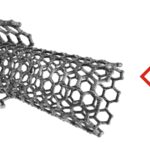
Risks associated with carbon nanotubes

Risks associated with carbon nanotubes
By the AVICENN team – Last added March 2025
Because of their sometimes long, fibrous form, reminiscent of asbestos, carbon nanotubes raised strong concerns about their toxicity very early on.
The long multi-walled carbon nanotubes (NTCs) classified as carcinogens
In 2017, the International Agency for Research on Cancer (IARC) classified one of these nanotubes, Mitsui-7, as a ‘possible human carcinogen’ (2B). After many years, and a last consultation during the summer of 2021, the European Chemicals Agency (ECHA) validated in March 2022 the classification as carcinogenic by inhalation (cat. 1B) of long multiwall carbon (nano)tubes . This includes those with a diameter ≥ 30 nm and < 3 μm, a length ≥ 5 μm and a width to height ratio > 3:11Cf. Echa’s Rac agrees to carcinogenic classification for multi-walled carbon tubes, Chemical Watch, March 23, 2022 . . This classification follows the submission of a dossier by Germany for the inclusion of the substance in Annex VI of the CLP Regulation.
Attention, short ones can also be toxic
In 2023, contrary to the initial belief that only long and thick multi-walled carbon nanotubes (NTCs) pose a problem, an in-depth study by the French National Institute for Research and Safety (INRS) reveals that short and thin NTCs, like their long and thick counterparts, induce acute pulmonary inflammation. Additionally, for short and thin NTCs, chronic inflammation and hyperplasia were observed, which are not observed for long and thick NTCs. This study is based on in vivo and in vitro experiments and has been the subject of a doctoral thesis2Cf. Hélène Barthel, Influence of physical parameters of multiwall carbon nanotubes on their toxicological properties in a bronchial epithelial cell model: reconciliation with pulmonary effects in rats, PhD Thesis, 2022 and two scientific articles3Barthel et al, Needlelike, short and thin multi-walled carbon nanotubes: comparison of effects on wild type and p53+/- rat lungs, Nanotoxicology, 2023 and Barthel et al, Continuous Long-Term Exposure to Low Concentrations of MWCNTs Induces an Epithelial-Mesenchymal Transition in BEAS-2B Cells, Nanomaterials 2021.
A look back at previous episodes
In May 2014, the French Health Security Agency (ANSES) recommended a classification of carbon nanotubes as hazardous substances so that measures could be put in place to restrict their use or even ban their use in certain consumer applications.
In 2015, the Société pour l’étude, la protection et l’aménagement de la nature dans le Sud-Ouest (SEPANSO) issued an alert on the risks linked to the production of carbon nanotubes by Arkema in Mont (Pyrénées-Atlantiques) and asked for production to be stopped until the harmlessness of nanos could be established for employees, consumers and the environment4Cf. Mont: carbon nanotubes in the crosshairs of the Sepanso, La République des Pyrénées, February 25, 2015; see also ANSES, Avis relatif à “l’évaluation des risques liés au GRAPHISTRENGTH C100 réalisée dans le cadre du programme Genesis”, November 28, 2013.
In November 2019, carbon nanotubes are the first nanomaterials to be integrated into the SinList, a list of substances to be replaced urgently because deemed too dangerous5Cf. With its SinList, the NGO ChemSec alerts a non-expert public to chemical risks, Novethic, November 2019 and New chemicals on the SIN List challenge the global supply chain, ChemSec, November 2019.
The same month, the European Agency for Safety and Health at Work awarded the 2018-2019 Healthy Workplaces Good Practice Award to Atlas Copco Industrial Technique, a Swedish manufacturing company that has taken a precautionary approach to minimizing worker exposure to carbon nanotubes6Cf. Sweden: protecting workers from potentially hazardous carbon nanotubes in manufacturing, OSHA Europe, November 2, 2019.
In July 2020, ECHA published an assessment report on multiwall carbon nanotubes (MWCNTs: a tube-shaped and entangled synthetic graphite) conducted by the German Institute for Occupational Safety and Health (BAuA)7Cf. SUBSTANCE EVALUATION CONCLUSION as required by REACH Article 48 and EVALUATION REPORT for Multi-walled Carbon Nanotubes (MWCNT), synthetic graphite in tubular shape and tangled, BAuA / ECHA, July 2020. The report pointed out that the information required by 1 January 2020 under REACH had not yet been (sufficiently) filled in by registrants and that additional measures were therefore necessary, starting with a compliance check. Once the data required by REACH is provided by companies, ECHA may decide whether additional information would be needed. ECHA was urging registrants to update their dossiers and/or develop testing proposals to comply with REACH requirements.
In the United States, the U.S. Environmental Protection Agency (EPA) has issued several Significant New Use Regulations (SNURs) for carbon nanotubes, requiring anyone wishing, for commercial purposes, to manufacture, import, or process these carbon nanotubes to notify the EPA at least 90 days before. 2 of these SNURs are:
- one in 2020, concerning free PMN P-15-54 (i.e. not included in a matrix)8Cf. Significant New Use Rules on Certain Chemical Substances (20-1.5e) – § 721.11467Carbon nanotubes (generic), EPA, September 17, 2020, which came into force on November 16, 2020
- one in 2021, concerning PMN P-18-182 multiwalled9Cf. Significant New Use Rules on Certain Chemical Substances § 721.11361 Multiwalled carbon nanotubes (generic), EPA, 18 August 2021
In 2021, carbon nanotubes have been identified as one of the four most risky categories of nanomaterials by a team from University College Dublin10Cf. A semiquantitative risk ranking of potential human exposure to engineered nanoparticles (ENPs) in Europe, Li, Y and Cummins, E, Science of the Total Environment, 778, July 2021.
Explore the bibliography below to learn more.
In French :
- Les nanomatériaux carbonés : synthèse, fonctionnalisation, caractérisation, applications, toxicité, E Flahaut et Raul Arenal, Webinaires Matériaux, Fédération française des matériaux (FFM) et Association Française pour l’Avancement des Sciences (AFAS), 20 June 2024
- Règlement délégué (UE) 2024/2564 modifiant le règlement (CE) no 1272/2008 en ce qui concerne la classification et l’étiquetage harmonisés de certaines substances, Commission européenne, 19 June 2024
- INRS, Carbon nanotubes: improving understanding of health effects, November 2023
- Hélène Barthel, Influence of physical parameters of multi-walled carbon nanotubes on their toxicological properties in a model of bronchial epithelial cells: correlation with pulmonary effects in rats, Doctoral thesis, 2022
- INRS, Long-term exposure of BEAS-2B cells to low concentrations of MWCNT is responsible for the induction of epithelial-mesenchymal transition, Barthel H et al, Nanomaterials, 11, 1742, 2021
- Françoise Pons (University of Strasbourg), Impact des caractéristiques physicochimiques sur l’effet inflammatoire et pro-allergisant respiratoires des nanoparticules manufacturées, presentation at the Anses & ADEME Scientific Meetings on Air Quality, October 17, 2019
- Flahaut E et al, Toxicity of carbon nanotubes towards humans and the environment, Techniques de l’ingénieur, October 2018
- elektor, Long fiber carbon nanotubes are carcinogenic, November 2017
- ANSES, Impacts of carbon nanotubes on health: relationship structure inflammatory effects, Hadj-Ziane-Zafour A., Bulletin de veille scientifique, n°32, October 2017
- IARC, Monograph – Carcinogenicity of Carbon Nanotubes, Vol.111, 2017
- Chakroun R, Influence on the toxic effects of simultaneous exposure to nanoparticles and metals, Science Watch Bulletin No. 30, ANSES, October 2016
- Dekali S, Carbon nanotubes: new advances on exposure models for the study of health hazard, Science Watch Bulletin No. 30, ANSES,October 2016
- Larue C, Where do we stand on the ecotoxicology of carbon nanotubes, Science Watch Bulletin No. 29, ANSES, September 2016
- CNRS, Carbon nanoparticles: a better assessment of their toxicity, June 2, 2016
- Elgrabi D et al, How do carbon nanotubes degrade in the human body, press release, Université Paris Diderot, 9 December 2015 (scientific publication in English here)
- Loïc Chauveau, À Paris, des nanotubes de carbone dans les poumons d’enfants asthmatiques, Sciences & Avenir, 23 October 2015
- “Imogolite nanotubes: a new model material in nanotoxicology?” by Rose J et al, in Participant’s file prepared for the Restitution of the National Environmental Health and Work Research Program (PNREST), October 2015
- C. Endes et al, Cotton fibers in place of carbon nanotubes, NRP 64, May 2015.
- La République des Pyrénées, Mont : les nanotubes de carbone dans le collimateur de la Sepanso, 25 February 2015
- Bourdiola F et al, Measuring the impact of carbon nanotubes in the environment, CNRS, January 2015
- Figarol A, In vitro toxicity and physicochemical properties of carbon nanotubes, thesis, Ecole nationale supérieure des Mines de Saint-Etienne, November 2014
- Flahaut E, Evaluation of the potential environmental impact of carbon nanotubes, Nanomaterials Industrial Days, Armines, (video), April 2014
- Boudard D, Bio toxicity in vitro of Carbon Nanotubes, Nanomaterials Industrial Days, Armines, (video), April 2014
- AtouSanté, Toxicology of nanotubes – Analogy between carbon nanotubes and asbestos – Exposure limit value at the workstation, March 2014
- Techniques de l’Ingénieur, Toxicity mitigation of carbon nanotubes through chemical functionalization, January 10, 2014
- ANSES, Opinion on “the risk assessment of GRAPHISTRENGTH C100 carried out in the framework of the Genesis program”, November 28, 2013 (online January 9, 2014)
- Veillenanos, Health effects of carbon nanotubes – Avoiding repeating the mistakes of asbestos, 26 Nov. 2013
- Mouchet F. et al, Carbon nanotubes: what are the risks for the environment, Biofutur, 32/347, 29-33, October 2013: work has shown acute (mortality, reduced mobility) and chronic (growth inhibition) toxicity effects, mainly related to their ingestion by exposed organisms, but at concentrations described as not environmentally representative (from 10 mg/L).
- CNRS, Long carbon nanotubes, risks similar to asbestos?, 15 January 2013
- ANSES, Toxicity and ecotoxicity of carbon nanotubes – Note d’actualité, État de l’art 2011-2012, November 2012
- ANSES, Opinion on the risk assessment of GRAPHISTRENGTH C100 conducted under the Génésis program, (carbon nanotubes), April 2012
- Electronic Newsletters Sweden, Swedish study warns of health risks of carbon nanotubes, March 7, 2011
- HCSP, Opinion on the safety of workers during exposure to carbon nanotubes, Referral of June 16, 2008 from the Director General of Health, January 7, 2009.
- INRS, Les nanotubes de carbone : quels risques, quelle prévention, Note documentaire, 2008
In English:
- Cellular uptake of multi-walled carbon nanotubes is associated to genotoxic and teratogenic effects towards the freshwater diatom Nitzschia linearis , Evariste L et al., Aquatic Toxicology, 275, Octobre 2024
- Carbon nanotubes alter agrosystem multifunctionality, Leroy M et al., Environ. Sci.: Nano, 11, 4126-4137, 2024
- Regulation (EU) 2024/2564 amending Regulation (EC) No 1272/2008 as regards the harmonised classification and labelling of certain substances, Euopean Commission, 19 June 2024
- Interactive effects of metals and carbon nanotubes in a microcosm agrosystem, Leroy et al, Journal of Hazardous Materials, June 2022
-
Inflammatory response, reactive oxygen species production and DNA damage in mice after intrapleural exposure to carbon nanotubes, RS Wils et al, Toxicological Sciences, September 2021
- Comparative study of response of four crop species exposed to carbon nanotube contamination in soil, C Liné et al., Chemosphere, July 2021
- Multi-Walled Carbon Tubes (synthetic graphite in tubular shape) with a geometric tube diameter range ≥ 30 nm to <3 μm and a length ≥ 5 μm and aspect ratio > 3:1, including Multi-Walled Carbon Nanotubes; [MWC(N)T]: Classification Carc. 1B, H350i, STOT RE 1, H372 ECHA, 2021
- Continuous Long-Term Exposure to Low Concentrations of MWCNTs Induces an Epithelial-Mesenchymal Transition in BEAS-2B Cells, Barthel H et al, Nanomaterials, 11(7), 1742, 2021
- A semiquantitative risk ranking of potential human exposure to engineered nanoparticles (ENPs) in Europe, Li, Y and Cummins, E, Science of the Total Environment, 778, July 2021
- Understanding the Broad Class of Carbon Nanotubes and Nanofibers (CNT/F) Used or Produced in U.S. Facilities, Erdely A et al, NIOSH Science blog, January 5, 2021
- Significant New Use Rules on Certain Chemical Substances (20-1.5e) – § 721.11467Carbon nanotubes (generic), EPA, September 17, 2020
- Science for Environment policy, Incinerating nano-enabled thermoplastics linked to increased PAH emissions and toxicity, European Commission DG Environment News Alert Service, 508, 24 May 2018
- Laux P et al, Challenges in characterizing the environmental fate and effects of carbon nanotubes and inorganic nanomaterials in aquatic systems, (Critical Review), Environ. Sci.: Nano, 5, 48-63, 2018
- Liné C, Carbon nanotubes: Impacts and behaviour in the terrestrial ecosystem – A review, Carbon, 123: 767-785, October 2017
- Chernova T et al, Long-fiber carbon nanotubes replicate asbestos-induced mesothelioma with disruption of the tumor suppressor gene, Current Biology, 27( 21), 3302-3314, November 2017 (see abstract in French: Les nanotubes de carbone à fibre longue sont cancérogènes, elektor, November 2017
- Mottier A et al, Environmental impact of engineered carbon nanoparticles: from releases to effects on the aquatic biota Environmental impact of engineered carbon nanoparticles: from releases to effects on the aquatic biota, Current Opinion in Biotechnology, 46, 1-6, August 2017
- Carbon nanotubes: Impacts and behaviour in the terrestrial ecosystem – A review, Liné C et al, Carbon, 123; 767-785, July 2017
- IARC, IARC Monographs – Some Nanomaterials and Some Fibers, Volume 111, 2017
- OECD, Single-Walled Carbon Nanotubes, July 2016
- Mottier A et al, Surface Area of Carbon Nanoparticles: A Dose Metric for a More Realistic Ecotoxicological Assessment, Nano Letters, 16 (6): 3514-3518, 2016
- Polimeni M et al, Multi-walled carbon nanotubes directly induce epithelial-mesenchymal transition in human bronchial epithelial cells…, Particle and Fibre Toxicology, 13: 27, June 2016
- Zeng W et al, The influence of inhaled multi-walled carbon nanotubes on the autonomic nervous system, PF&T, 13:8, 2016
- Elgrabli D et al, Carbon Nanotube Degradation in Macrophages: Live Nanoscale Monitoring and Understanding of Biological Pathway, ACS Nano, 9 (10): 10113-10124, 2015
- Schubauer-Berigan MK et al, Epidemiologic studies of U.S. workers handling carbon nanotubes: the interface between exposure and health, NIOSH (USA), slide presentation at the Quantifying Exposure to Engineered Nanomaterials Workshop, July 2015
- Grosse Y et al, Carcinogenicity of fluoro-edenite, silicon carbide fibres and whiskers, and carbon nanotubes, 15(13): 1427-1428, December 2014
- Vasyl Harik, Carbon Nanotubes and Safety, in Trends in Nanoscale Mechanics, August 2014, pp 197-211
- Powers C M et al. Sparking Connections: Toward Better Linkages Between Research and Human Health Policy – An Example with Multiwalled Carbon Nanotubes, Toxicological Sciences, 141(1): 6-17, June 2014
- Schierz A et al, Fate of single walled carbon nanotubes in wetland ecosystems, Environ. Sci.: Nano, 2014
- Czarny B et al, Carbon Nanotube Translocation to Distant Organs after Pulmonary Exposure: Insights from in Situ 14C-Radiolabeling and Tissue Radioimaging, ACS Nano, 8 (6): 5715-5724, May 2014
- IARC, IARC Advisory Group Recommends Multi-Walled Carbon Nanotubes as High Priority, May 14, 2014
- The Lowell Center for Sustainable Production, Precarious Promise: A Case Study of Engineered Carbon Nanotubes, University of Massachusetts Lowell, March 2014
- Gernand JM and Casman EA, A Meta-Analysis of Carbon Nanotube Pulmonary Toxicity Studies -How Physical Dimensions and Impurities Affect the Toxicity of Carbon Nanotubes, Risk Analysis, 34(3): 583-597, March 2014
- Siegrist KJ et al, Genotoxicity of multi-walled carbon nanotubes at occupationally relevant doses, Particle and Fibre Toxicology, 11:6, 2014
- Nymark P., et al, Free radical scavenging and formation by multi-walled carbon nanotubes in cell free conditions and in human bronchial epithelial cells, Particle and Fibre Toxicology, 11:4, 2014
- Sargent LM et al, Promotion of lung adenocarcinoma following inhalation exposure to multi-walled carbon nanotubes, Particle and Fibre Toxicology, January 2014, 11:3
- FIOH (Finland), Evaluation of the health effects of carbon nanotubes, October 2013
- RISS (Japan), Guide to measuring airborne carbon nanotubes in workplaces, National Institute of Advanced Industrial Science and Technology (Japan), October 2013
- Mercer et al, Extrapulmonary transport of MWCNT following inhalation exposure, Particle and Fibre Toxicology, 10:38, August 2013
Any questions or comments? This information sheet compiled by AVICENN is intended to be completed and updated. Please feel free to contribute.
Our information sheets to go further
Upcoming Nano Agenda

- E-learning program: awareness-raising for personnel who come into contact with nanomaterials during research, formulation, production, maintenance, cleaning, upkeep, etc., as well as safety coordinators or engineers, facility managers, heads of laboratories where nanoparticles are handled.
- Organizers: INSTN Grenoble (CEA)
- On the program:
- 1 – Introduction, definition and characteristics of nanomaterials
- 2 – Toxicity of nanomaterials: the state of knowledge
- 3 – Metrology and characterization of nanomaterials
- 4 – Prevention and protection against nanomaterials in the workplace
- 5 – Quiz: assessment of learning outcomes
- The 2-hour course can be viewed for one month from the date of registration.
- Website: https://instn.cea.fr/…risques-lies-aux-nanomateriaux…

- Scientific conference
- 23rd International conference on Advanced Nanomaterials
- From July 23 to July 25, 2025
- Website: www.advanced-nanomaterials-conference.com

- E-learning program: awareness-raising for personnel who come into contact with nanomaterials during research, formulation, production, maintenance, cleaning, upkeep, etc., as well as safety coordinators or engineers, facility managers, heads of laboratories where nanoparticles are handled.
- Organizers: INSTN Grenoble (CEA)
- On the program:
- 1 – Introduction, definition and characteristics of nanomaterials
- 2 – Toxicity of nanomaterials: the state of knowledge
- 3 – Metrology and characterization of nanomaterials
- 4 – Prevention and protection against nanomaterials in the workplace
- 5 – Quiz: assessment of learning outcomes
- The 2-hour course can be viewed for one month from the date of registration.
- Website: https://instn.cea.fr/…risques-lies-aux-nanomateriaux…
This sheet was originally created in December 2013
Notes and references
- 1Cf. Echa’s Rac agrees to carcinogenic classification for multi-walled carbon tubes, Chemical Watch, March 23, 2022 .
- 2
- 3Barthel et al, Needlelike, short and thin multi-walled carbon nanotubes: comparison of effects on wild type and p53+/- rat lungs, Nanotoxicology, 2023 and Barthel et al, Continuous Long-Term Exposure to Low Concentrations of MWCNTs Induces an Epithelial-Mesenchymal Transition in BEAS-2B Cells, Nanomaterials 2021
- 4Cf. Mont: carbon nanotubes in the crosshairs of the Sepanso, La République des Pyrénées, February 25, 2015; see also ANSES, Avis relatif à “l’évaluation des risques liés au GRAPHISTRENGTH C100 réalisée dans le cadre du programme Genesis”, November 28, 2013
- 5Cf. With its SinList, the NGO ChemSec alerts a non-expert public to chemical risks, Novethic, November 2019 and New chemicals on the SIN List challenge the global supply chain, ChemSec, November 2019
- 6Cf. Sweden: protecting workers from potentially hazardous carbon nanotubes in manufacturing, OSHA Europe, November 2, 2019
- 7
- 8Cf. Significant New Use Rules on Certain Chemical Substances (20-1.5e) – § 721.11467Carbon nanotubes (generic), EPA, September 17, 2020
- 9
- 10Cf. A semiquantitative risk ranking of potential human exposure to engineered nanoparticles (ENPs) in Europe, Li, Y and Cummins, E, Science of the Total Environment, 778, July 2021






